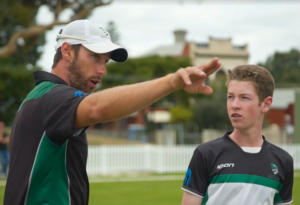Over the time I’ve spent working with and developing 1000’s of players games, I’ve seen a pattern emerge.
There are key area’s that players neglect, sometimes by choice, other times just because they don’t understand the magnitude of the role that this particular area plays on their game. This comes with inexperience and a lack of exposure to high level coaching/mentoring.
Below are the 7 area’s of the game that we found many players both senior and junior neglect.
It’s becoming better in these area’s that we’ve found great improvements in players games.
You’ve all hit 4’s or felt amazing in the middle or in the nets…
You’ve all bowled the perfect ball once, or your stock ball really well many times…
And for keepers you’ve all felt amazing and confident behind the stumps…
This tells me that you’ve all got the ability to execute your skill better than what you do all the time, it’s just a matter of harnessing this more often.
1. Developing Plans
Having a better understanding of your strength/weaknesses is so important. Having a strength based approach to the way you play enables you to play the game on your terms.
Having clearly defined batting or bowling plans is the best way for players to feel more confident and comfortable when out in the middle.
Being able to tap into a certain plan for a right arm out swing bowler, and knowing how they are trying to get you out, what type of shots they want you to play, what are the low risk/easier shots for you to play all form a basis of this plan.
And when it comes time to face another type of bowler you click straight into that plan to make scoring against that type of bowler easier.
In our programs we actually get bowlers and batters to set out their plans against types of bowlers, or for bowlers set their fields for the type of bowler that they are so that they can see these clearly and problem solve with our coaches.

(It's key to even speak to your coaches and players about this at training)
2. Training An Easy Option
Neglecting areas of your game that are uncomfortable/hard is the easiest and most common thing many players do.
Batting in the easy net, or having throw downs that are half volleys, or even putting the bowling machine on hitting half volleys for half an hour.
These aren’t going to make you better. Yes there is a time to train in these environments but the key to becoming a better player is to make training tough and to get out of your comfort zone.
I’m sure you’ve all heard of the term train hard play easy? Many players shy away from training short balls or doing things they aren’t so good as because it’s a natural reaction because they don’t want to fail.
If you are training something hard or uncomfortable, break the skill down into smaller parts or use softer balls etc to get the confidence first. You are only going to get better at it by doing it, if you neglect it for long enough it’s going to affect your game.
3. Physical
This is a massive area that needs to improve within community and amateur level’s. Players neglect the physical component of the game.
Many people think crickets an easy game that doesn’t require any sort of physical fitness (think meat pie for lunch and sinking cans of beer).
However, to truly be consistent and perform over longer periods of time and also to perform at your top level you need to be fit and strong enough.
Bowling enough overs to take enough wickets, batting for 2 hours or getting from 20 - 50 or to make more than 50 requires you to be performing your skill at a high level for long periods.
Even the mental side of the game is directly influenced on the physical side. The fitter you are, the easier it is to recover and make repeat efforts, but also enables you to recover and switch back on and make better decisions due to less fatigue.
It’s all about training the body correctly.
4. Using Your Time Between Balls
You may have heard us speak about the time in between each ball being critical.
For many players, this time between balls is used negatively or neglected totally. Your ability to control your thoughts, feelings and emotions during this time goes a long way to contributing to a far better performance in your skill set.
The time in between balls is crucial, and many things can affect what you do/think then. Thinking too far in the past or too far ahead of yourself are key components that many players are guilty of.
It’s trying to steer these thoughts away and turning it into a positive time to help you reflect and then keep your composure and commit yourself to your batting/bowling plans.
Having a between ball routine, or using positive imagery, controlling your breathing to lower heart rate are all things that can help with using this time for the better.
It’s all about avoiding distractions that take you away from your plans and focus.
5. Pre Game Preparation
Not many people think about the days before the game and how that influences performance. Many players when you say pre game they think the morning of, or in the warm up.
Ensuring you receive enough rest/sleep the night before.
Eating a nutritious night before meal so you have enough energy.
Using mental skills techniques (visualisation, meditation or even reviewing your plans as a batter or bowler).
Ensuring you are prepared to perform to your best and having the mindset to know that you’ve done all you need to during the week to ensure you can perform to your best.
These are routines and habits to get into, not superstitions. Habits and routines are what you repeat in order to get the most out of your time before you play to ensure you can play to your best.
Use this time effectively and find what works for you. This is a process that only you can control. Don’t copy other people as it may not fit in with you.
6. Reviewing/Reflection
A critical time after you’ve played a game or trained.
Understanding what you are doing well but also to learn from errors or parts of the game and identify these area’s for improvement.
This may be done by journalling and writing these down, or simply sitting in the car or in the change rooms at the end of the game or session.
The importance of this is however, that you identify things you are doing well, but also what you need to improve.
Use this review as a basis of planning out what your focus needs to be during training next session or what is important this week during your game.
7. Growth Mindset
Finally, this last one all comes down to a mindset you take.
The actions that come from it are overall going to be what makes you take on these extra areas.
We speak of having a growth mindset, a throw away word if not understanding what the meaning is.
Having a growth mindset is being open to getting better, doing the things that you need to do to learn from mistakes…Picking out key people who have already walked the path that you are and finding and extracting all of the information you can to make better decisions.
Understanding what is beneficial to your development and what isn’t.
This is the key under riding factor that will get you to where you want to go.
Now I’m not saying that you have to start doing all these straight away…
However if you do spend time on developing these area’s, or even at least just being aware of these, you will become a far more well rounded player.
As you can see, these factors contribute to your performance on a cricket field. It’s not just batting and bowling.
However we seem to only really just train how to hit a ball, throw a ball, bowl a ball and catch a ball, weird huh..
Written By Joel Hamilton (Co Founder of the ACI)

